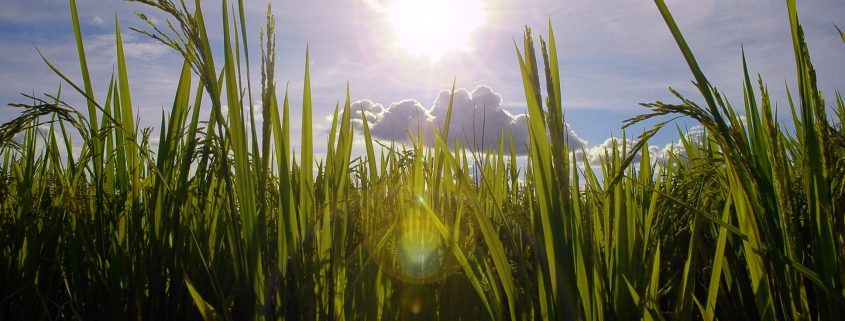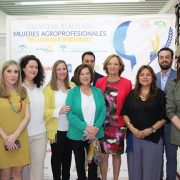Over 60% of the rice that matter the European Union (EU) into the mainland without paying any duty and 40% paid only 30 euros per ton, a tariff almost 90% less than they paid 10 years ago. This situation has caused major rice producers such as Cambodia, Burma and India are clearly unfair competition, saturated European markets rice.
This indiscriminate increase in rice imports poses a serious threat to the continuity of cultivation in the European Union, at least this was what held all industry representatives who spoke yesterday at the XV Rice Day organized by ASAJA-Seville and Rice Federation of Sevilla in the Low Island (La Puebla del Rio) estate.
 The conference, organized with the traditional patronage of the Caja Rural del Sur Foundation and in collaboration with Asegasa, Dow AgroSciences and the Provincial de Sevilla, is organized around a round table in which representatives of the rice industry, the sector producer, the crop protection sector, governments, the European Parliament and the Doñana Natural Area, in which the issues of most concern to this sector were addressed: imports, market prices and the aid of the new CAP, the relationship with the Doñana, the damage caused by the birds and the problems caused by the reduction of pesticides suitable for the treatment of pests and diseases of rice.
The conference, organized with the traditional patronage of the Caja Rural del Sur Foundation and in collaboration with Asegasa, Dow AgroSciences and the Provincial de Sevilla, is organized around a round table in which representatives of the rice industry, the sector producer, the crop protection sector, governments, the European Parliament and the Doñana Natural Area, in which the issues of most concern to this sector were addressed: imports, market prices and the aid of the new CAP, the relationship with the Doñana, the damage caused by the birds and the problems caused by the reduction of pesticides suitable for the treatment of pests and diseases of rice.
Andalusia is the first rice-growing region of Spain. In the marshes of Seville and Cadiz region of Janda 44% of all rice harvested in Spain, and the weight of the Andalusian production is rising occurs, since it is the only community that, unable to find an alternative crop and despite the price reduction at source has remained constant surface in the last five seasons.
As noted managing director of the Federation of Rice, Manuel Cano, Sevilla has 37,000 hectares devoted to rice, with a clear predominance of the variety of long grain or Indica, which encompasses 80% of production, while the remaining 20% is of the Japonica variety of round or grain. The average harvest in the province this year will be around 350,000 tonnes, with an average yield close to 9,000 kilos per hectare. Which puts Seville rice farmers as the first in the world for its productivity.
It is precisely these high returns which allow the crop still remains, because with the high costs of supporting the rice production if yields were lower, the industry would be at a loss. Because as evidenced Manuel Cano, prices have started very low, between 280 and 285 euros / tonne for the indica variety and between 300 and 340 euros / tonne for Japonica.
However, facing this season, some experts suggest that may be a turn in the market, because although the current prices are lower than a year ago in all varieties, exporting countries have less availability of rice The climate phenomenon “El Niño” has reduced the crop forecast in Southeast Asia and is expected global consumption exceeds production, which can create some tension in the market and affect up prices Europeans could benefit rice, especially at a time like the present, where the value of the euro is low against the dollar. This was the thesis said Juan Carlos Marcos, technical director of the General Department of Arable Crops and Industrial MAGRAMA.
However, and as noted by the purchasing manager of Ebro Foods, Juan Farias, the viability of farming in Europe can not rely on the phenomenon of “El Niño” and the possibility of a natural disaster in other producing countries, it is necessary to take measures to prevent unfair competition from cheap rice in Southeast Asia, so either we got compensation to our farmers in the same proportion as prices fall, or get the European Union to make use of the clause safeguards to protect its rice sector or contingenta the amount of rice that can enter each of these third countries.
 More than 1,600 trade agreements in force
More than 1,600 trade agreements in force
Possible solutions feasible sees the vice president of the Committee on Agriculture of the European Parliament, Clara Aguilera, who noted that the trend of CAP reforms in the past has been to reduce agricultural support and, in parallel, to open the market European agricultural production to third countries.
Clara Aguilera said the EU has 1,600 trade agreements in force and is involved in more than a dozen trade facilitation negotiations with third countries. Although, as recognized by the vice president of the Committee on Agriculture, this agreement was made without a study of previous impact on EU agriculture without an impact of the alleged improvements in the populations of the beneficiary countries, so he said that one of the objectives that will pursue from Parliament is to make the European Commission undertakes to keep track of the consequences of these agreements.
In her opinion, a large part of the responsibility for the price reduction at source of rice is due to imbalance in the food chain under pressure from large distributors, who in their eagerness to undercut prices and distort markets.
And it is that as Manuel Cano notes that European producers to produce rice profitably, the original value would have to be above 350 euros / tonne. The European rice
It is of better quality than Asian rice with which it is competing unfairly, as regulation and social and European environmental legislation obliges us to produce some expenses than have countries such as Cambodia, Thailand, Vietnam and India.
In this line also deepened the director of the department of records for Spain and Portugal of Dow Agrosciences Iberica, Cristina Adalid, who noted that the EU is making it increasingly difficult for the industry for plant protection and farmers themselves, who are staying helpless to deal with the diseases of crops. Thus, in the last 10 years the cost has to take a company that intends to bring a new plant protection product on the market exceeds 250 million euros, the equivalent of half new bridge in Cadiz. And, as revealed Cristina Adalid, new more restrictive legislation was approved without measuring their impact on agriculture and production.
The Head of Agricultural Production of the Ministry of Agriculture, Marcelino Bilbao, became interested in the problems identified in some batches of certified seed this season, and promised to hold a meeting with the seed growers and all the sector to discuss the issue and to avoid this problem in the next campaign.
Finally, the manager of the Doñana Natural Area, José Juan Chans, advocated the survival of rice in Doñana, since this crop has contributed to the growth and recovery of many species, such as cabochons, and loss rice ecosystem would be a catastrophe.
Source: ASAJA-Sevilla. Rice Federation Seville










